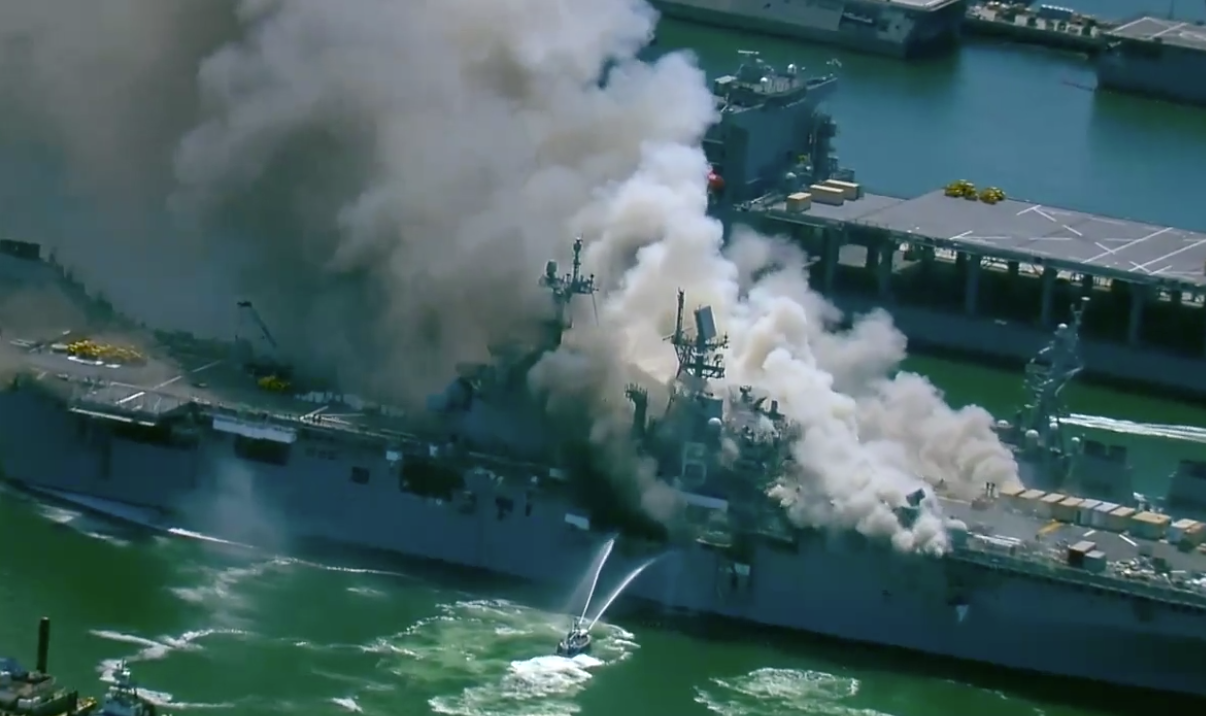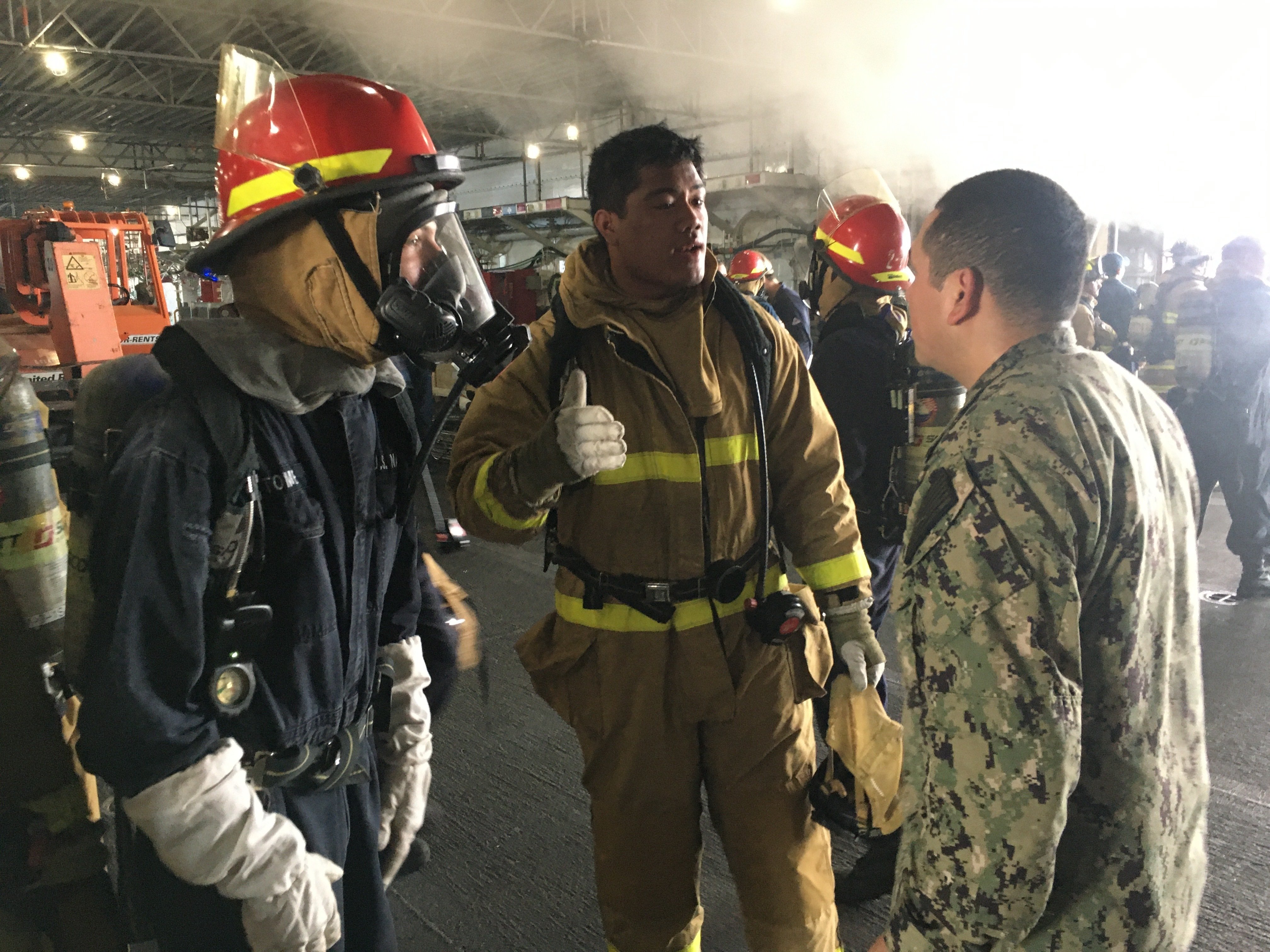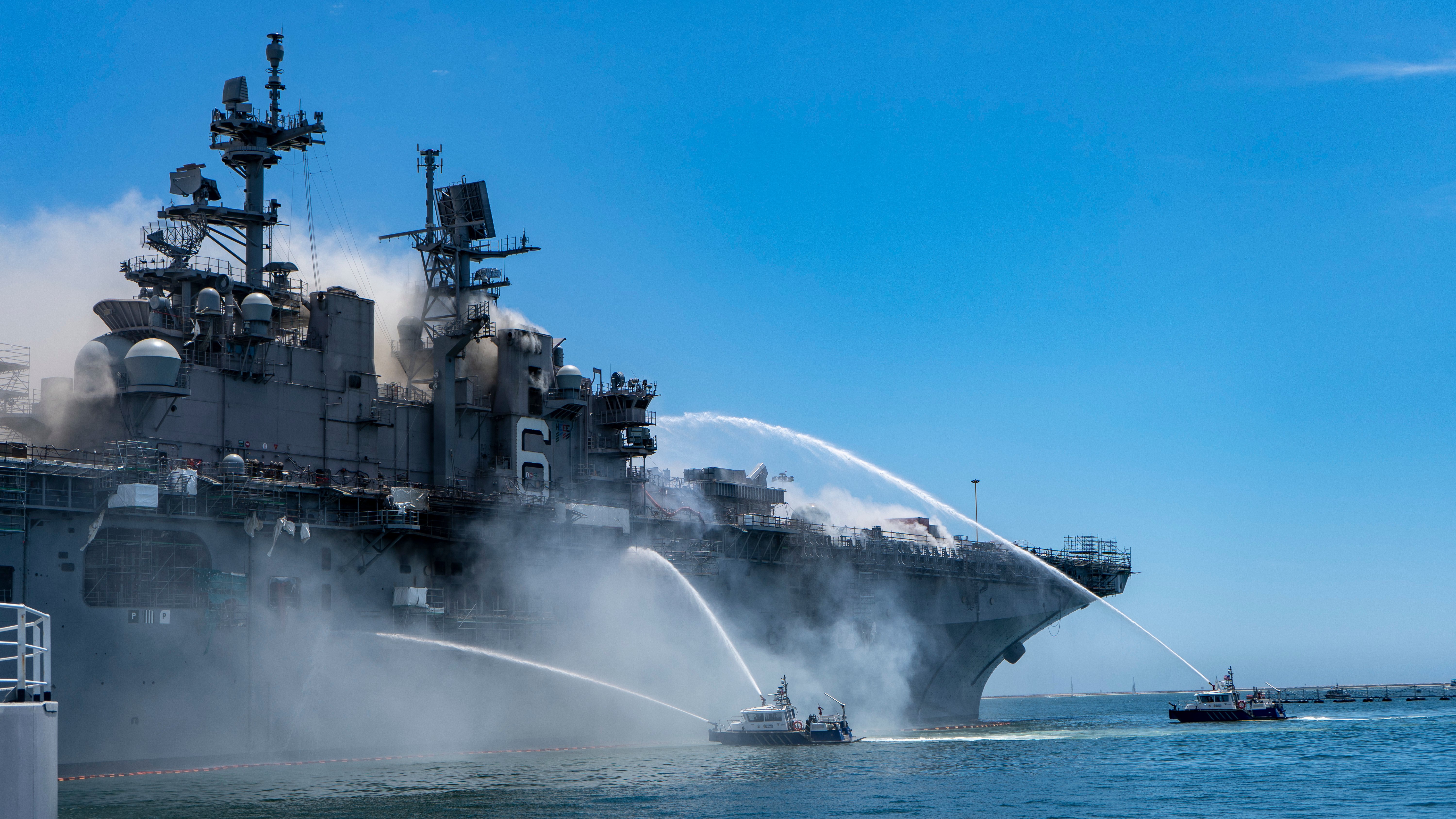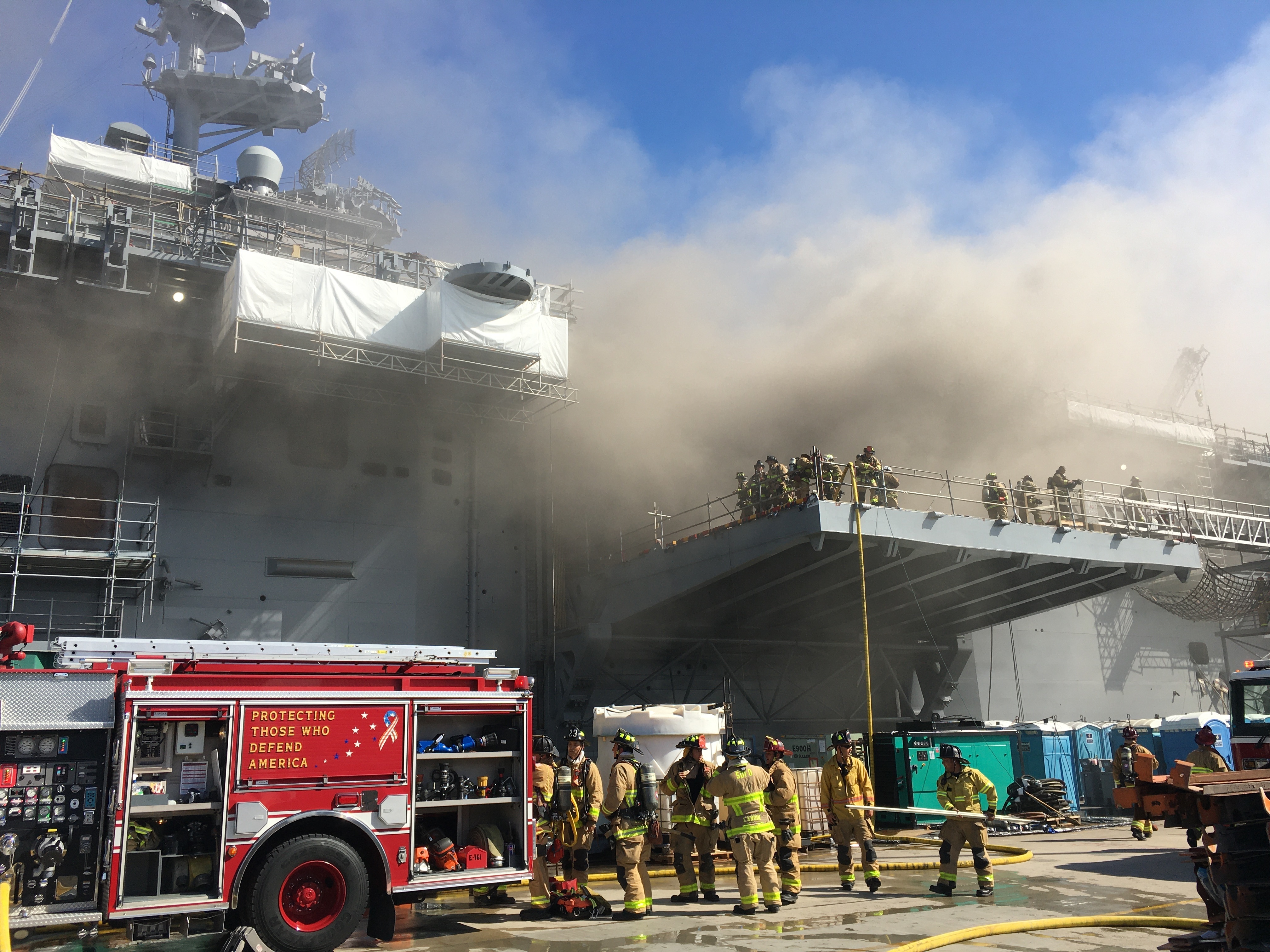
This is the final version of this post. Click here for continued USNI News coverage of the fire on USS Bonhomme Richard (LHD-6).
SAN DIEGO, Calif. – A fire that broke out Sunday morning in amphibious assault ship USS Bonhomme Richard (LHD-6) sent 17 sailors and four civilian workers to local hospitals, Naval Surface Force Pacific officials said.
Billowing clouds of white and black smoke poured into the clear, blue sky throughout the morning as local and federal fire and rescue crews responded to the multiple-alarm fire aboard the gray hull, berthed at Pier 2 at Naval Base San Diego. By late afternoon, fire boats continued to pour water onto the ship at Naval Base San Diego in a futile effort to stem the smoke and quash the fires still burning on the 844-foot-long ship, which was going through a maintenance period.
“Seventeen sailors and four civilians are being treated for non-life threatening injuries at a local hospital,” Mike Raney, a SURFPAC spokesman, said in an afternoon statement that updated a previous report of 18 injured sailors. “All inport ships have been contacted and directed to provide fire parties to possibly assist with firefighting efforts.” All personnel were accounted for, officials reported.
About 160 sailors were aboard Bonhomme Richard when the fire was reported about 8:30 a.m., according to SURFPAC. The ship, with a crew of about 1,000, “is going through a maintenance availability.”
It’s unclear whether any crew were staying aboard the ship, but aerial video showed a berthing barge was parked nearby, and it didn’t appear to be damaged by the fire.
In a Sunday evening press conference, Navy officials provided additional details on the fire.
“There was a report of an internal explosion” in a lower stowage area, Rear Adm. Philip Sobeck, Expeditionary Strike Group 3, told reporters during an evening press conference at the base. “We don’t quite understand yet the source of….the seed of the fire,” he added.
Sailors with ship’s company initially responded to fight the fire before base fire crews were called in. By evening, sailors and federal firefighters continued to attack the fire inside the ship and were putting firefighting foam on the Class A fire, which was continuing to be fueled by debris and materials in the ship’s internal spaces, “normal things” typically inside a ship such as office equipment and clothing.
“There is no ordnance onboard, which was our initial concern for safety,” Sobeck said, referring to Navy and fire officials’ concerns about the safety of crews fighting inside the ship. Navy and San Diego authorities set an 1,800-foot perimeter around the ship and a one nautical mile safety zone in San Diego Bay. “There’s always that concern,” he said, noting efforts to cool the hull with water through as many access points as possible to thwart any further explosions. “Right now, the risk is low for those secondary explosions.”
Sobeck said he didn’t have available specific details of the sailors’ injuries but described them as likely smoke inhalation and heat exhaustion. “All are in stable condition at this point,” he said, adding, “we want to make sure they’re well taken care of.”

“We’re absolutely going to make sure it sails again, but we don’t know,” Sobeck said, adding “we’re going to learn a lot probably from this. We’ll let that investigation and those lessons be identified.”
The big-deck amphib was moored at a pier shared by two Burke-class destroyers, USS Russell (DDG-59) and USS Fitzgerald (DDG-62). Fitzgerald, which arrived in San Diego following a lengthy repair period in Mississippi after a 2017 fatal collision with a container ship off Japan, “shifted berths to a pier further away from the fire” about 1 p.m., a hasty move that happened as even as the gangway connected the ship to the pier. Russell shifted berths a half-hour later, the Navy said.
Investigators will be looking at what was happening aboard the ship before the fire was reported. It’s unclear yet what caused the fire, which happened during a weekend with sparse crews and during a maintenance availability, and an investigation will look at what happened.
“The origin of the fire is still unknown and is pending investigation,” Raney said in a statement.
It’s been two years since the Wasp-class Bonhomme Richard returned to San Diego after a six-year stint in Japan as the flagship for the 7th Fleet’s amphibious force. The ship began a $249 million Docking Phased Maintenance Availability in late 2018, a series of repair, upgrades and maintenance expected to be completed by May 2020, according to the contract award announcement. The ship, which joined the fleet in 1998, has carried thousands of sailors and Marines to combat zones and missions across the Persian Gulf, Southeast Asia and western Pacific.
Local firecrews with the San Diego Fire Department responded to the scene at 8:50 a.m., some 20 minutes after the fire was reported to the Navy. Dozens of fire vehicles, ladder trucks and ambulances from San Diego and local departments, as well as the federal fire service, descended onto the base and Pier 2.
Defensive fire suppression continued throughout the afternoon.
Federal Fire San Diego was the on-scene lead for firefighting efforts, according to SURPPAC. “Currently there are two firefighting teams fighting the fire aboard the ship,” Federal Fire San Diego Division Chief Rob Bondurant said in a statement issued late Sunday afternoon. “Federal Fire is rotating their crews aboard the ship with U.S. Navy firefighting crews from the waterfront to fight the fire in order to find the seat of the fire and extinguish it. Also, Navy Region Southwest tugs are also continuously combatting the fire from the bay.”
Earlier in the day, several explosions were heard as the fire spread throughout the ship’s decks and fire crews fought the smoke and flames from the pier and from fire boats. At one point, about noon, a shipboard official told fire officials that small arms but not ordnance were aboard the ship, according to San Diego Fire-Rescue Department radio transmissions heard by USNI News. Shortly after, all San Diego fire crews were ordered off the pier, according to the broadcast and an SDFD Twitter posting.

A ship like Bonhomme Richard has lots of combustible materials aboard, such as oxygen and acetylene tanks and especially given the ongoing repair and maintenance, said Sal Mercogliano, a merchant mariner and associate professor of history at Campbell University. Combustibles put out heavy, black smoke in a fire, and there was quite a bit of it spewing from multiple spaces and exterior hatches along with white smoke.
Mercogliano, who is also a certified firefighter, said it’s possible the fire was smoldering for some time before it was reported. Ships like Bonhomme Richard, which has an expansive flight and hangar deck to accommodate helicopters, tiltrotors and short-takeoff and landing jets, have built-in damage control and firefighting systems. Typically, “a shipboard fire counts upon the ship having engine and firepump capacity to fight the fire,” he said. “But if a ship is dead, not able to charge its firefighting systems, it makes it a world of difference harder.”

“That’s a problem you have with fighting a fire on ship. If you can’t use the shipboard fighting system, it is next to impossible to put that fire out because of the length you have to lay hoses into the vessel,” Mercogliano said, noting a typical firetruck has 1,000 feet of large diameter hose. Fire suppression requires water as well as types of foams designed to put out specific sources of fire fuels, he added, and a pier crowded with containers, pallets, heavy equipment and heavy lines also makes it difficult to pull close firefighting equipment including ladder trucks if needed.
While fireboats sprayed water onto the ship, fire suppression efforts also require attacking the fire inside the ship “to hit the feet of the fire, or she’s going to keep smoldering the way she is,” he added, noting the June 4 fire of a car carrier ship berthed in Jacksonville, Fla., that injured nine firefighters and burned for day.
Since the fire happened during an availability, the investigation “is going to be multi-fold, because you’re going to have contractors onboard, so the question is going to be, did the contractors secure equipment like they were supposed to. Were the proper fire watches set, if any hot work was done? Were shipboard inspections being done?” Mercogliano said. “How lax were the fire barriers and watertight protections onboard the ship during this period of time. There’s a lot of issues that are going to have to be examined, and a lot of finger-pointing.”





